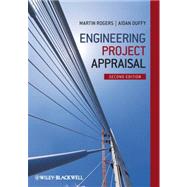
Note: Supplemental materials are not guaranteed with Rental or Used book purchases.
Purchase Benefits
What is included with this book?
Aidan Duffy BA, BAI, MBA, PhD is a lecturer at the Dublin Institute of Technology where he specialises in the financial, economic and policy assessment of renewable energy technologies and energy efficient systems.
Introduction, xv
PART 1 ECONOMICS-BASED PROJECT APPRAISAL TECHNIQUES, 1
1 Decision Making and Project Appraisal, 3
1.1 Decision making context, 3
1.2 Techniques for decision making, 4
1.3 Primacy of the rational model, 13
1.4 Decision-making conditions, 14
1.5 Project planning process, 16
1.6 Example of a decision process, 22
1.7 Summary, 25
1.8 Review of succeeding chapters, 26
2 Basic Tools for Economic Appraisal 29
2.1 Introduction, 29
2.2 The time value of money, 29
2.3 The estimation of interest, 30
2.4 Simple and compound interest, 31
2.5 Nominal and effective interest rates, 33
2.6 Continuous compounding, 34
2.7 Time equivalence, 35
2.8 Economic computation, 37
2.9 Summary, 50
3 Present Worth Evaluation 51
3.1 Introduction, 51
3.2 Present worth – the comparison process, 52
3.3 Summary, 65
4 Equivalent Annual Worth Computations 67
4.1 Introduction, 67
4.2 The pattern of capital recovery, 67
4.3 Modifying annual payments to include salvage value, 69
4.4 Evaluating a single project, 71
4.5 The comparison process, 72
4.6 Summary, 77
5 Rate of Return Computation 79
5.1 Introduction, 79
5.2 Minimum Acceptable Rate of Return (MARR), 79
5.3 Internal Rate of Return (IRR), 80
5.4 IRR for a single project, 80
5.5 Incremental analysis, 87
5.6 Summary, 94
6 Benefit/Cost Ratio, Depreciation and Taxation 96
6.1 Introduction, 96
6.2 Costs, benefits and disbenefits, 96
6.3 Estimating the benefit/cost ratio for a single project, 97
6.4 Comparing mutually exclusive options using incremental benefit/cost ratios, 98
6.5 Depreciation, 99
6.6 Taxation, 102
6.7 Summary, 104
7 Cost–Benefit Analysis of Public Projects 107
7.1 Introduction, 107
7.2 Historical background to cost–benefit analysis, 108
7.3 Theoretical basis for cost–benefit analysis, 110
7.4 The procedure of cost–benefit analysis, 111
7.5 Identifying the main project options, 111
7.6 Identifying costs and benefits, 111
7.7 Placing valuations on all costs and benefits/disbenefits, 112
7.8 Assessing and comparing the cost–benefit performance of options, 115
7.9 Sensitivity analysis, 117
7.10 Final decision, 119
7.11 Case study: the cost–benefit analysis of a highway improvement project, 119
7.12 Case study: water supply scheme in a developing country, 128
7.13 Case study: cost–benefit analysis of sewer flooding alleviation, 135
7.14 Advantages and disadvantages of traditional cost–benefit analysis, 137
7.15 Techniques for valuing non-economic impacts, 138
7.16 Using cost–benefit analysis within different areas of engineering, 148
7.17 Summary, 151
8 Economic Analysis of Renewable Energy Supply and Energy Efficient Projects 154
8.1 Introduction, 154
8.2 Policy context, 154
8.3 Renewable energy supply and energy efficient technologies, 157
8.4 Economic measures for renewable energy and energy efficient projects, 163
8.5 Estimating GHG emissions, 179
8.6 Uncertainty, 183
8.7 Case studies, 186
9 Value for Money in Construction 193
9.1 Definition of Value for Money, 193
9.2 Defining Value for Money in the context of a construction project, 194
9.3 Achieving Value for Money during construction, 194
9.4 Whole-life costing, 195
9.5 The concept of ‘milestones’, 196
9.6 Detailed description of the Value for Money framework, 197
9.7 Value for Money and design, 206
9.8 Is there a conflict between Sustainability and Value for Money, 211
9.9 The role of better managed construction in delivering projects on time and within budget, 213
10 Other Economic Analysis Techniques 216
10.1 Introduction, 216
10.2 Cost effectiveness, 216
10.3 The Planned Balance Sheet, 220
10.4 Hill's Goal Achievement Matrix, 227
10.5 Summary, 239
PART 2 NON-ECONOMIC-BASED PROJECT APPRAISAL TECHNIQUES 241
11 Multicriteria Analysis 243
11.1 Introduction, 243
11.2 Multicriteria evaluation models, 244
11.3 Simple non-compensatory methods, 246
11.4 Summary, 255
12 The Simple Additive Model 257
12.1 Background, 257
12.2 Introduction to the Simple Additive Weighting (SAW) Method, 259
12.3 Sensitivity testing, 261
12.4 Probabilistic Additive Weighting, 264
12.5 Assigning weights to the decision criteria, 270
12.6 Checklists, 282
12.7 Case Study: Using the Simple Additive Weighting Model to choose the best transport strategy for a major urban centre, 292
12.8 Summary, 298
13 Analytic Hierarchy Process (AHP) 300
13.1 Introduction, 300
13.2 Hierarchies, 301
13.3 Establishing priorities within hierarchies, 301
13.4 Establishing and calculating priorities, 303
13.5 Relationship between AHP and the Simple Additive Weighting (SAW) model, 316
13.6 Summary, 316
14 Concordance Techniques 318
14.1 Introduction, 318
14.2 Concordance Analysis, 319
14.3 PROMETHEE I and II, 321
14.4 ELECTRE I, 328
14.5 Other Concordance Models, 331
14.6 Summary, 339
15 Concluding Comments 343
15.1 Introduction, 343
15.2 Which project appraisal technique should one use? 343
15.3 Future challenges, 344
References, 345
Interest Factor Tables, 346
Index, 368
The New copy of this book will include any supplemental materials advertised. Please check the title of the book to determine if it should include any access cards, study guides, lab manuals, CDs, etc.
The Used, Rental and eBook copies of this book are not guaranteed to include any supplemental materials. Typically, only the book itself is included. This is true even if the title states it includes any access cards, study guides, lab manuals, CDs, etc.